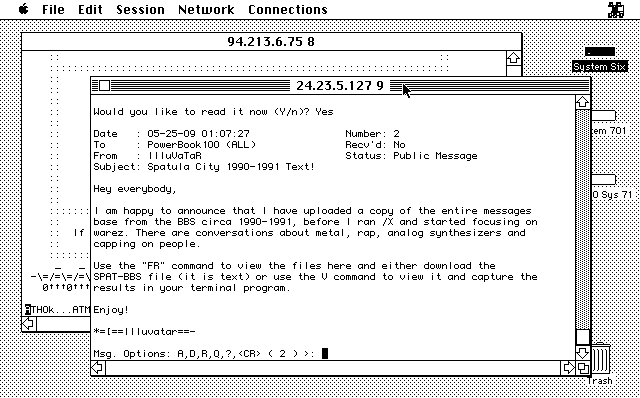The Wireless PowerBook 100
By Edward Mendelson
The PowerBook 100 | Adding Ethernet | Networking with System 6.0.8. 7.0.1, and 7.1 | Screenshots
The PowerBook 100 (vintage 1991)
 Apple released the PowerBook 100 portable computer in 1991, years before wireless networking came
to the world of personal computers. This page tells how I brought wireless networking to a PowerBook 100,
and used a wireless connection to print to networked printers and to connect to the Internet.
Apple released the PowerBook 100 portable computer in 1991, years before wireless networking came
to the world of personal computers. This page tells how I brought wireless networking to a PowerBook 100,
and used a wireless connection to print to networked printers and to connect to the Internet.
The PowerBook 100 was slightly misnamed even at the time it was released. It was powered by a 16MHz 68000 processor. Out of the box, it came with either a 20 MB SCSI hard disk or a 40 MB drive. It shipped by default with 2 MB of RAM, which could be expanded, at great expense, to 8 MB by adding a 6 MB memory chip. The tiny screen displayed 640 x 400 pixels, each pixel displayed in one of two colors - black or white. It weighed 5.1 pounds, perhaps the most impressive fact about it, as most other portable computers at the time were considerably heavier, although far more powerful.
The back panel of the PowerBook 100 is a feast for anyone who feels nostalgia for obsolete forms of connectivity. It includes an ADB (Apple Data Bus) port, an audio-out jack, a proprietary Apple serial port for connecting a printer, a proprietary Apple port for connecting an external floppy disk drive, and a proprietary SCSI connector. An internal port allows the addition of a 2,400-baud modem. By default, the operating system that came with the machine was Apple's System 7.0.1, although it could also run the older and less sluggish System 6.0.8, and could be upgraded to System 7.1 (or even 7.5.5), which brought additional features and even slower performance.
I bought mine for $25 on eBay, and I suspect that I overpaid.
Adding Ethernet to a Ethernet-less Machine
 One thing that the PowerBook 100
did not provide in its default configuration is Ethernet networking, and Apple
never provided an Ethernet option for the machine. So, in my quest for wireless
networking for this computer, the first step was to add wired Ethernet.
One thing that the PowerBook 100
did not provide in its default configuration is Ethernet networking, and Apple
never provided an Ethernet option for the machine. So, in my quest for wireless
networking for this computer, the first step was to add wired Ethernet.
The only practical way to do this is through a SCSI-Ethernet adapter. I chose the Asante Micro EN/SC, a small box that plugs into the PowerBook's SCSI port and provides a painfully slow 10Mbps connection; the box also has a small power cable that plugs into the PowerBook's ADB port. A standard Ethernet cable plugs into the Micro EN/SC through an RJ-45 jack. I bought all this for $10 on eBay.
I plugged the adapter into the PowerBook. Then I plugged one end of an Ethernet cable into the adapter's RJ-45 jack. Finally, I plugged the other end of the cable into an Airport Express wireless unit. I had earlier set up the Airport Express unit so that it could extend a network, and the Airport Express was already wirelessly linked to an Airport Extreme router.
I started the machine, installed the drivers for the Micro EN/SC from a disk in the external floppy drive, and (if I remember correctly) set up TCP/IP networking with a fixed IP address, because the networking software was unable to receive an address via the DHCP method universally used in later years. I then restarted the machine so that I could use it to connect to my network.
Networking with System 7.1, 7.0.1, and 6.0.8
I experimented with three different operating systems. Running under System 7.1 and 7.0.1, I used the NCSA Mosaic web browser to connect to the world-wide web, the Chooser to choose between two network printers, and Fetch to connect to an FTP server. Unfortunately, I couldn't find a web browser that ran on this machine under System Six, but I was able to use NCSA Telnet to connect to some of the few surviving Telnet sites on the internet. I also used MacPing to scan my network.
System 7.1 was released in August 1992. Faster and more efficient methods of connecting with the Internet have reportedly been made available in later years.
Some screen shots from the PowerBook 100
System 6.0.8 with two telnet windows:

System 6.0.8 with MacPing:

System 7.0.1 with NCSA Mosaic:

System 7.1 with the Chooser and NCSA Mosaic:

Edward Mendelson First posted 25 July 2010; last revised 16 July 2013.